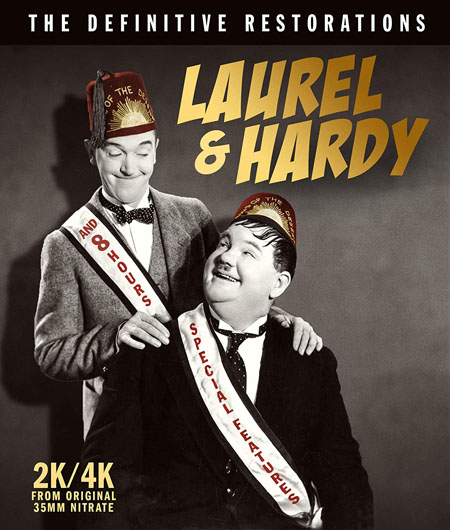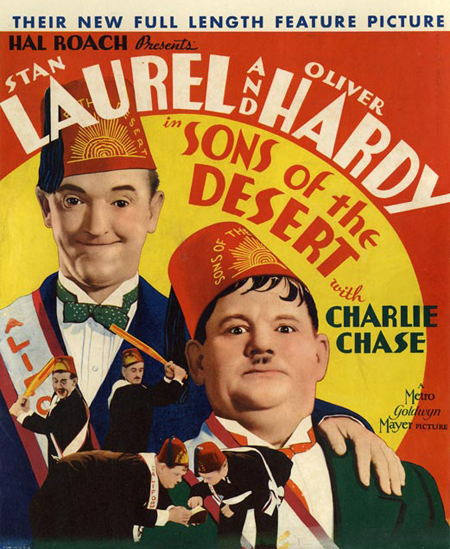
“A
GORGEOUS NICE MESSâ€
By
Raymond Benson and Doug Gerbino
Nobody
wants the legacy of Stan Laurel and Oliver Hardy to disappear. Young people may
have heard of the comic duo, but few have seen them these days. This is understandably
disturbing to cinephiles or those of us of an older generation who have admired
since childhood the genius on display when the pair performed in front of the
camera. While RHI Entertainment issued a fabulous DVD set in 2011 (10 disks in
the U.S.) that contained most of Laurel and Hardy’s output for Hal Roach after
sound kicked in, a new Blu-ray treasure chest has just been released by
MVDvisual that contains stunning restorations in high definition of a
respectable number of titles.
Laurel
and Hardy—The Definitive Restorations could be a holy grail for members of Sons of
the Desert, the International Laurel and Hardy Society that is devoted to
keeping the lives and works of Stan and Ollie before the public “and have a
good time doing it.†It is also a must for anyone who has even a passing
interest in the history of film comedy or film in general.
The
four-disk set contains two of the duo’s most revered feature films—Sons of
the Desert (1933) and Way Out West (1937) along with seventeen
classic shorts released between 1927 and 1933. Two of the shorts, Berth
Marks (1929) and Brats (1930) are presented twice, each with two
different soundtracks—one with the original Vitaphone track and the other with the
re-issued 1936 version.
Sons
of the Desert might
be the definitive Laurel and Hardy movie. In it, both boys must deceive their
suspicious wives about attending the Shriners-like “Sons of the Desertâ€
convention in Chicago. Of course, one lie turns into a hundred and they keep
digging their holes deeper. Way Out West is a western, naturally, with
the boys attempting to deliver a gold mine deed to the rightful owner, only to
be hoodwinked by the villains. The picture contains the celebrated dance
routine Stan and Ollie performs while the Avalon Boys sing “At the Ball, That’s
All.â€
All
of the shorts are marvelous. The Oscar-winning The Music Box (1932) is
there, plus favorites such as the two with different soundtracks, and Hog
Wild (1930), Come Clean (1931), County Hospital (1932), and Busy
Bodies (1933). But the shining star of the set is the long “lost†but
recently found silent gem, The Battle of the Century (1927), which
contains the pie fight to end all pie fights. This is a seminal work in the
Laurel and Hardy canon, and it had seemed that since 1957 only three minutes of
footage of the approximately twenty-minute film was thought to exist. In 1980,
Leonard Maltin found the bulk of reel one in the archive of the Museum of
Modern Art (what, they didn’t know they had it?). In 2015, film historian John
Mirsalis discovered the complete reel two. There are still two to three minutes
missing—the new set makes up for it by including stills and intertitles—but with
The Definitive Restorations we now have an almost complete version on
home video. The film comes with a new music track by Donald Sosin. Look for a
young Lou Costello as an extra in the crowd ringside during the early boxing
match sequence! In short, the inclusion of The Battle of the Century is worth
the price of admission.

The
restorations by Jeff Joseph/SabuCat in conjunction with the UCLA Film and
Television Archive and Library of Congress are simply beautiful. The
contributions by film historians, archivists, and Laurel and Hardy scholars
Randy Skretvedt and Richard W. Bann can’t be understated. Bann commented to the
reviewers, “I saved the nitrate film from being disposed of and gave it to
UCLA. We did our own commercial restoration and preservation for the Eastern
hemisphere (though 35mm fine grains were provided at cost to the Western
Hemisphere copyright proprietor, which generated what you see on TCM and in the
Essential Laurel and Hardy DVD box set). Once I steered the nitrate to
UCLA, Jeff Joseph donated money and oversaw the institutional restoration and
preservation, as well as the digital upgrade, something we did not do for
Munich originally, owing to time and cost considerations, as well as because
the technology was less advanced during the 1985-2002 period. I supplied the
still photos for the extras, except for those which came from Oliver Hardy’s
collection. I consulted on the matter of rights clearances. I loaned studio
documents, pressbooks, etc., to be scanned for inclusion with the extras, and I
loaned the Kodachrome print of The Tree in a Test Tube.â€
The
nearly nine hours of supplements are just as spectacular as the films
themselves. Skretvedt and Bann share the commentary duties (Bann is on The
Battle of the Century and The Music Box, while Skretvedt does the
rest). The combined knowledge of these two film aficionados about the history
of Laurel and Hardy and Hal Roach Studios makes the set a must-have for
devotees of the boys. In addition, there are 2,500 rare photos, posters, and
studio files; film and audio interviews with many of the duo’s co-workers and
Sons of the Desert society attendants of the 60s; a 50s-era interview with
Hardy aboard the ship sailing from England during the period depicted in the
recent biopic, Stan and Ollie (and it’s amazing how much the aging Hardy
resembles the made-up John C. Reilly!); a restoration from 16mm Kodachrome of
the rare 1942 color short produced by the U.S. Department of Agriculture, The
Tree in a Test Tube; and trailers. The interviews, mostly conducted
by Skretvedt in the early 1980s, are of varying audio and visual quality. Unfortunately,
when asked what the chances are of locating a print of the ultra-rare lost 1927
silent film, Hat’s Off, Bann answered, “In the words of Oliver Hardy,
‘Null and void!’ We will cover all bets for finding Hat’s Off giving 100
to 1 odds.â€
This
isn’t just “another nice mess†they’ve got you into, it’s a gorgeous nice
mess. Laurel and Hardy—the Definitive Restorations is highly and most
enthusiastically recommended.
For
information about the Sons of the Desert, visit www.sonsofthedesertinfo.com.
The society was founded in 1965 by John McCabe, who wrote the first true
biography of Stan Laurel and Oliver Hardy in 1961. McCabe wanted to start an
organization dedicated to the love of the duo along the lines of The Baker
Street Irregulars (honoring Sherlock Holmes). McCabe had Laurel’s blessing, as
long as no one referred to the society as a “fan club.†“Fan†is short for
“fanatic,†and he didn’t want that. The society has been going strong with
worldwide chapters—called “tentsâ€â€”ever since.
CLICK HERE TO ORDER FROM AMAZON
